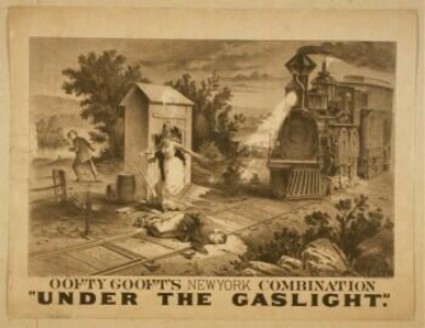 In order to understand the conventions of film music, either from the silent or the sound era (including the silent-to-sound transitional period of 1926-1936), it is useful to look at the theatrical and dramatic practices of the 18th and 19th century. Studying the music and staging conventions of Melodrama, for instance, help us to answer questions about the specific uses and effects of music in cinema (dialogue and action accompaniment, stylistic conventions), the role of entertainment in modern industrial societies (middle and working class audiences, sentimentalism, moralization, representation of reality), and the impact of technologies in the production of spectacles for the masses (database/library combinatory practices).
In order to understand the conventions of film music, either from the silent or the sound era (including the silent-to-sound transitional period of 1926-1936), it is useful to look at the theatrical and dramatic practices of the 18th and 19th century. Studying the music and staging conventions of Melodrama, for instance, help us to answer questions about the specific uses and effects of music in cinema (dialogue and action accompaniment, stylistic conventions), the role of entertainment in modern industrial societies (middle and working class audiences, sentimentalism, moralization, representation of reality), and the impact of technologies in the production of spectacles for the masses (database/library combinatory practices).
 Examining 19th century drama as a theatrical process, Michael Pisani has identified the complex set of relations between music and dramatic text, acting style, and scenic design. In “Music for the Theatre: Style and Function in Incidental Music,” Pisani helps us understand how the theatrical drama of the 19th century industrial societies, especially in London and New York City, relied in a sophisticated and varied set of music accompaniment devices (derived from French Melodrama, Italian opera, Austro-Germanic topics of 18th century music) and music practices (recycling, stringing together of pre-existing music, use of libraries/collections of music, combinations of original music-classical works-popular melodies). Such eclectic practices and “mechanics of production,” were embodied by the film music accompaniment of the silent era, and the transitional period of silent-to-sound cinema (1926-1935). David Neumeyer has illustrated such historic and poetic continuum in “Melodrama as Compositional Resource in Early Hollywood Sound Cinema.” By studying the compositional practices of Max Steiner (The Informer, Now, Voyager, Since You Went Away, Casablanca, Gone by the Wind) Neumeyer reveals how the technique of melodrama (speech accompanied by music) was adapted and innovated in Hollywood cinema (late 1920-1930s).
Examining 19th century drama as a theatrical process, Michael Pisani has identified the complex set of relations between music and dramatic text, acting style, and scenic design. In “Music for the Theatre: Style and Function in Incidental Music,” Pisani helps us understand how the theatrical drama of the 19th century industrial societies, especially in London and New York City, relied in a sophisticated and varied set of music accompaniment devices (derived from French Melodrama, Italian opera, Austro-Germanic topics of 18th century music) and music practices (recycling, stringing together of pre-existing music, use of libraries/collections of music, combinations of original music-classical works-popular melodies). Such eclectic practices and “mechanics of production,” were embodied by the film music accompaniment of the silent era, and the transitional period of silent-to-sound cinema (1926-1935). David Neumeyer has illustrated such historic and poetic continuum in “Melodrama as Compositional Resource in Early Hollywood Sound Cinema.” By studying the compositional practices of Max Steiner (The Informer, Now, Voyager, Since You Went Away, Casablanca, Gone by the Wind) Neumeyer reveals how the technique of melodrama (speech accompanied by music) was adapted and innovated in Hollywood cinema (late 1920-1930s).
Music, however, as John Fell demonstrates in “Dissolves by Gaslight: Antecedents to the Motion Picture in Nineteenth-Century Melodrama,” was just one of the formal elements of melodrama that cinema, the spectacle for the masses of the 20th century, embodied. Moments of pathetic sentiment, fast transitions in space and between scenes, spatial juxtapositions, panoramas, special effects, lighting, and stage architecture, were some of the Victorian melodrama theatrical conventions that defined the new medium of film. By embodying melodrama, Anglo-Saxon cinema did not only organize the mechanics of production of the new urban spectacle, but also the mechanics of emotions of the audiences from industrial capitalist societies.
References
John L. Fell, “Dissolves by Gaslight: Antecedents to the Motion Picture in Nineteenth-Century Melodrama,” Film Quarterly 23, no. 3 (Spring, 1970): 22-34.
Michael Pisani, “Music for the Theatre: Style and Function in Incidental Music,” in Kerry Powell, ed. Cambridge Companion to Victorian and Edwardian Theatre (Cambridge University Press, 2004), 70-92.
David Neumeyer, “Melodrama as a Compositional Resource in Early Hollywood Sound Cinema.” Current Musicology 57 (1995): 61-94.
La mode femme en ligne : toute la mode femme sélectionnée par la rédaction de Elle.fr. Découvrez les dernières nouveautés mode des femmes : défilés… ray ban
Hi there, You have done an excellent job. I’ll definitely digg it and personally recommend to my friends. I’m confident they’ll be benefited from this web site.